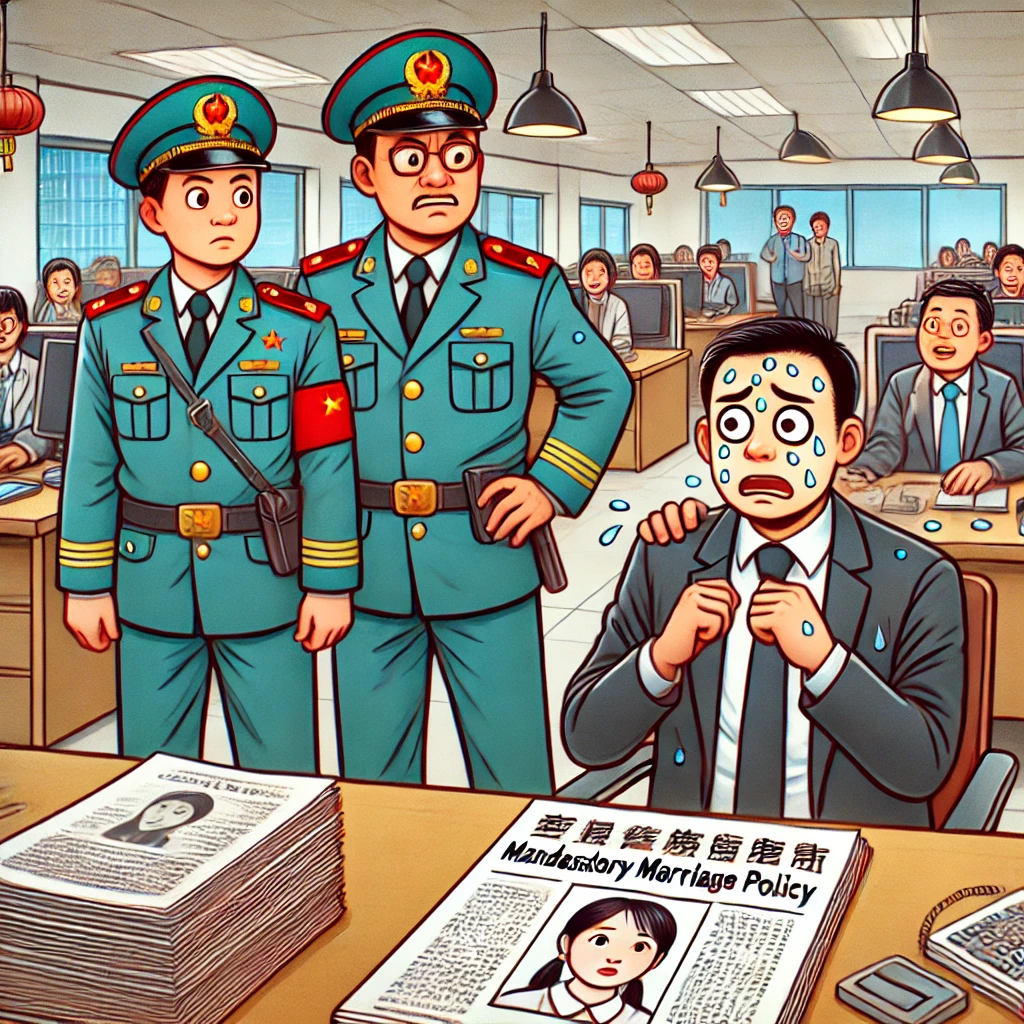A company in China has recently retracted a controversial policy that threatened to terminate the employment of single workers if they did not marry by the end of September. The Shuntian Chemical Group, located in Shandong province, had issued a notice to its 1,200 employees, specifically targeting those aged between 28 and 58. The notice demanded that these unmarried individuals, including those who had previously been divorced, “resolve your personal marriage issues” by the specified deadline, or face consequences.
The company’s announcement outlined a series of escalating measures for non-compliance. Initially, employees were required to submit a self-reflection if they remained unmarried by the first quarter. If they failed to marry by the second quarter, the company would conduct an evaluation of their situation. Ultimately, those who did not establish a family by the third quarter risked having their labor contracts terminated. The notice further criticized single employees for not adhering to the national encouragement to marry and have children, labeling them as “disloyal” and “disobedient” to parental guidance.
This policy emerged amidst a broader initiative by the Chinese government to address the declining birth rate in the country. Authorities have been promoting marriage and family formation among younger generations to counteract this demographic trend. However, the Shuntian Chemical Group’s approach was met with significant backlash on social media, where many users expressed their disapproval of the company’s demands.
In response to the public outcry, local officials from the human resources and social security bureau intervened, visiting the company to highlight the policy’s violation of Chinese labor laws. Following this intervention, the Shuntian Chemical Group promptly withdrew the notice the next day. A representative from the company acknowledged that the language used in the announcement was inappropriate, leading to its retraction.
Recent government statistics indicate a troubling trend in China, with the number of new marriages dropping by 20% last year, marking the largest decline on record. Additionally, the population has decreased for the third consecutive year, now standing at approximately 1.408 billion. These figures underscore the challenges the country faces in reversing its declining birth rate and the complexities surrounding marriage and family formation in contemporary Chinese society.
Original news source: Chinese company that set deadline for single workers to get married responds to criticism (Sky News)
🎧 Listen:
Slow
Normal
Fast
📖 Vocabulary:
| 1 | retracted | To withdraw or take back something previously stated or agreed upon |
| 2 | controversial | Causing disagreement or discussion |
| 3 | terminate | To bring something to an end or halt |
| 4 | escalating | Increasing in intensity or severity |
| 5 | compliance | The act of conforming to a rule or request |
| 6 | adhering | Sticking to or following a rule or guideline |
| 7 | initiative | A plan or action intended to solve a problem or improve a situation |
| 8 | demographic | Relating to the structure of populations |
| 9 | backlash | A strong negative reaction or response |
| 10 | intervention | The act of becoming involved in a situation to alter the outcome |
| 11 | violation | An act of breaking or disregarding a law or rule |
| 12 | retraction | The act of taking back or withdrawing something |
| 13 | consecutive | Following one after another without interruption |
| 14 | underscore | To emphasize or highlight something |
| 15 | complexities | The state of being intricate or complicated |
Group or Classroom Activities
Warm-up Activities:
– CHARADES
Instructions: Students will choose a word or phrase related to the article (e.g., “marriage policy,” “backlash,” “employment contract”) and act it out without speaking while the rest of the class guesses the term.
– OPINION POLL
Instructions: Students will create a short survey with questions related to marriage and employment policies, such as “Should companies have a say in their employees’ personal lives?” After creating the survey, they will conduct it among their peers and share the results with the class.
– HEADLINE CREATION
Instructions: Students will be divided into small groups and tasked with creating a catchy headline for the article. They will then present their headlines to the class and discuss the reasoning behind their choices.
– THINK-PAIR-SHARE
Instructions: Pose a thought-provoking question related to the article, such as “What are the potential consequences of companies interfering in employees’ personal lives?” Students will first think individually, then discuss their thoughts with a partner, and finally share insights with the whole class.
– SYNONYM CHALLENGE
Instructions: Provide students with a list of vocabulary words from the article (e.g., “retract,” “controversial,” “evaluate”). Students will work in pairs to come up with synonyms for each word and share their findings with the class, discussing any nuances in meaning.
🤔 Comprehension Questions:
1. What was the controversial policy implemented by the Shuntian Chemical Group regarding single workers?
2. How did the company plan to enforce compliance with its marriage policy among unmarried employees?
3. What reasons did the company give for criticizing single employees in their notice?
4. How does the Shuntian Chemical Group’s policy relate to the broader initiative by the Chinese government?
5. What was the public reaction to the company’s marriage policy on social media?
6. What actions did local officials take in response to the policy implemented by the Shuntian Chemical Group?
7. What did a representative from the company acknowledge about the language used in the original announcement?
8. What recent statistics indicate the challenges China is facing regarding marriages and population growth?
Go to answers ⇩
🎧✍️ Listen and Fill in the Gaps:
A company in China has recently retracted a controversial policy that threatened to terminate the employment of single workers if they did not marry by the end of (1)______. The Shuntian Chemical Group, located in Shandong province, had issued a notice to its 1,200 employees, specifically targeting those aged between 28 and 58. The notice demanded that these unmarried (2)______, (3)______ those who had previously been divorced, “resolve your personal marriage issues” by the specified (4)______, or face consequences.
The company’s announcement outlined a series of escalating measures for non-compliance. Initially, employees were required to submit a self-reflection if they remained (5)______ by the first (6)______. If they failed to marry by the second quarter, the company would conduct an evaluation of their situation. Ultimately, those who did not establish a family by the third quarter risked having their labor contracts terminated. The notice further criticized single employees for not adhering to the national encouragement to marry and have children, labeling them as “disloyal” and “disobedient” to parental guidance.
This policy (7)______ amidst a broader initiative by the Chinese government to (8)______ the declining birth rate in the country. Authorities have been promoting marriage and family formation among younger generations to counteract this demographic trend. However, the Shuntian Chemical Group’s approach was met with significant (9)______ on social media, where many users expressed their disapproval of the company’s demands.
In response to the (10)______ outcry, local officials from the human resources and social security (11)______ intervened, visiting the company to highlight the policy’s violation of Chinese labor laws. Following this intervention, the Shuntian Chemical Group promptly (12)______ the notice the next day. A representative from the company acknowledged that the language used in the announcement was inappropriate, leading to its (13)______.
Recent government statistics indicate a troubling trend in China, with the number of new (14)______ dropping by 20% last year, marking the largest decline on record. Additionally, the population has decreased for the third (15)______ year, now standing at approximately 1.408 billion. These figures underscore the challenges the country faces in reversing its declining (16)______ rate and the complexities surrounding marriage and family formation in contemporary Chinese society.
Go to answers ⇩
💬 Discussion Questions:
Students can ask a partner these questions, or discuss them as a group.
1. What is your opinion on companies influencing employees’ personal lives, such as marriage and family decisions?
2. How would you feel if your employer set deadlines for you to get married or face consequences?
3. Do you think there should be limits to how much a company can involve itself in an employee’s private life? Why or why not?
4. What is a healthy work-life balance, and how can companies support their employees in achieving it?
5. How do societal expectations about marriage and family impact individuals in your culture?
6. Do you think government initiatives to promote marriage and family formation are effective? Why or why not?
7. What is your perspective on the relationship between personal happiness and societal expectations regarding marriage?
8. How would you react if you were pressured by friends or family to get married by a certain age?
9. Do you believe that being single can be as fulfilling as being married? Why or why not?
10. What are some potential consequences of a declining birth rate in a country?
11. How do you feel about the idea of labeling single individuals as “disloyal” or “disobedient”?
12. Do you think that the government should intervene in personal matters like marriage? Why or why not?
13. What is a significant challenge you think single individuals face in today’s society?
14. How would you feel if your job was at risk because of your marital status?
15. Do you think that cultural attitudes towards marriage are changing? Why or why not?
Individual Activities
📖💭 Vocabulary Meanings:
Match each word to its meaning.
Words:
1. retracted
2. controversial
3. terminate
4. escalating
5. compliance
6. adhering
7. initiative
8. demographic
9. backlash
10. intervention
11. violation
12. retraction
13. consecutive
14. underscore
15. complexities
Meanings:
(A) Causing disagreement or discussion
(B) The act of becoming involved in a situation to alter the outcome
(C) A strong negative reaction or response
(D) An act of breaking or disregarding a law or rule
(E) The act of conforming to a rule or request
(F) The act of taking back or withdrawing something
(G) Relating to the structure of populations
(H) Following one after another without interruption
(I) To withdraw or take back something previously stated or agreed upon
(J) Increasing in intensity or severity
(K) Sticking to or following a rule or guideline
(L) To bring something to an end or halt
(M) To emphasize or highlight something
(N) A plan or action intended to solve a problem or improve a situation
(O) The state of being intricate or complicated
Go to answers ⇩
🔡 Multiple Choice Questions:
1. What company in China recently retracted a controversial policy regarding unmarried employees?
(a) Huawei
(b) Shuntian Chemical Group
(c) Alibaba
(d) Tencent
2. What was the age range targeted by the Shuntian Chemical Group’s notice?
(a) 28 to 58
(b) 20 to 40
(c) 30 to 50
(d) 25 to 45
3. What consequence did unmarried employees face if they did not marry by the end of September?
(a) A pay cut
(b) Mandatory counseling sessions
(c) Termination of their labor contracts
(d) Relocation to another branch
4. What did the company label single employees who did not comply with the marriage policy?
(a) Irresponsible and careless
(b) Disloyal and disobedient
(c) Unmotivated and lazy
(d) Incompetent and untrustworthy
5. What demographic issue is the Chinese government trying to address with initiatives promoting marriage?
(a) Aging population
(b) High unemployment rate
(c) Urban migration
(d) Declining birth rate
6. How did local officials respond to the Shuntian Chemical Group’s policy?
(a) They supported the policy
(b) They ignored the complaints
(c) They proposed new regulations
(d) They highlighted its violation of labor laws
7. What was the percentage drop in new marriages in China last year according to government statistics?
(a) 20%
(b) 15%
(c) 10%
(d) 25%
8. How many consecutive years has the population in China decreased?
(a) Two years
(b) Four years
(c) Three years
(d) Five years
Go to answers ⇩
🕵️ True or False Questions:
1. A company in China recently retracted a policy that threatened to terminate single workers’ employment if they did not marry by the end of September.
2. The Shuntian Chemical Group is located in Beijing province and has 1,000 employees.
3. The policy outlined consistent measures for all employees, regardless of their marital status, including self-reflection and evaluations based on their performance.
4. Local officials from the human resources and social security bureau intervened, stating that the policy violated Chinese labor laws.
5. The policy was criticized on social media, leading to significant public backlash.
6. The company praised single employees as “loyal” and “compliant” for following national encouragement to marry and have children.
7. The uncontroversial notice broadly addressed both single and married employees aged between 25 and 60, including those who had previously been divorced.
8. Recent government statistics show that the number of new marriages in China dropped by 20% last year, marking the largest decline on record.
Go to answers ⇩
📝 Write a Summary:
Write a summary of this news article in two sentences.
Check your writing now with the best free AI for English writing!
Writing Questions:
Answer the following questions. Write as much as you can for each answer.
Check your answers with our free English writing assistant!
1. What specific age range did the Shuntian Chemical Group target with their controversial marriage policy?
2. What were the consequences outlined for employees who did not comply with the company’s marriage demands?
3. How did the public react to the Shuntian Chemical Group’s policy on social media?
4. What actions did local officials take in response to the company’s policy, and what was the outcome?
5. What broader demographic trend in China prompted the Shuntian Chemical Group to implement their marriage policy?
✅ Answers
🤔✅ Comprehension Question Answers:
1. What was the controversial policy implemented by the Shuntian Chemical Group regarding single workers?
The Shuntian Chemical Group implemented a policy that threatened to terminate the employment of single workers if they did not marry by the end of September.
2. How did the company plan to enforce compliance with its marriage policy among unmarried employees?
The company planned to enforce compliance by requiring unmarried employees to submit self-reflections, undergo evaluations, and face potential termination of their labor contracts if they did not marry by specific deadlines.
3. What reasons did the company give for criticizing single employees in their notice?
The company criticized single employees for not adhering to the national encouragement to marry and have children, labeling them as “disloyal” and “disobedient” to parental guidance.
4. How does the Shuntian Chemical Group’s policy relate to the broader initiative by the Chinese government?
The policy relates to the broader initiative by the Chinese government to address the declining birth rate by promoting marriage and family formation among younger generations.
5. What was the public reaction to the company’s marriage policy on social media?
The public reaction on social media was one of significant backlash, with many users expressing their disapproval of the company’s demands.
6. What actions did local officials take in response to the policy implemented by the Shuntian Chemical Group?
Local officials from the human resources and social security bureau intervened by visiting the company to highlight the policy’s violation of Chinese labor laws.
7. What did a representative from the company acknowledge about the language used in the original announcement?
A representative from the company acknowledged that the language used in the announcement was inappropriate, leading to its retraction.
8. What recent statistics indicate the challenges China is facing regarding marriages and population growth?
Recent statistics indicate that the number of new marriages dropped by 20% last year, marking the largest decline on record, and the population has decreased for the third consecutive year, now standing at approximately 1.408 billion.
Go back to questions ⇧
🎧✍️✅ Listen and Fill in the Gaps Answers:
(1) September
(2) individuals
(3) including
(4) deadline
(5) unmarried
(6) quarter
(7) emerged
(8) address
(9) backlash
(10) public
(11) bureau
(12) withdrew
(13) retraction
(14) marriages
(15) consecutive
(16) birth
Go back to questions ⇧
📖💭✅ Vocabulary Meanings Answers:
1. retracted
Answer: (I) To withdraw or take back something previously stated or agreed upon
2. controversial
Answer: (A) Causing disagreement or discussion
3. terminate
Answer: (L) To bring something to an end or halt
4. escalating
Answer: (J) Increasing in intensity or severity
5. compliance
Answer: (E) The act of conforming to a rule or request
6. adhering
Answer: (K) Sticking to or following a rule or guideline
7. initiative
Answer: (N) A plan or action intended to solve a problem or improve a situation
8. demographic
Answer: (G) Relating to the structure of populations
9. backlash
Answer: (C) A strong negative reaction or response
10. intervention
Answer: (B) The act of becoming involved in a situation to alter the outcome
11. violation
Answer: (D) An act of breaking or disregarding a law or rule
12. retraction
Answer: (F) The act of taking back or withdrawing something
13. consecutive
Answer: (H) Following one after another without interruption
14. underscore
Answer: (M) To emphasize or highlight something
15. complexities
Answer: (O) The state of being intricate or complicated
Go back to questions ⇧
🔡✅ Multiple Choice Answers:
1. What company in China recently retracted a controversial policy regarding unmarried employees?
Answer: (b) Shuntian Chemical Group
2. What was the age range targeted by the Shuntian Chemical Group’s notice?
Answer: (a) 28 to 58
3. What consequence did unmarried employees face if they did not marry by the end of September?
Answer: (c) Termination of their labor contracts
4. What did the company label single employees who did not comply with the marriage policy?
Answer: (b) Disloyal and disobedient
5. What demographic issue is the Chinese government trying to address with initiatives promoting marriage?
Answer: (d) Declining birth rate
6. How did local officials respond to the Shuntian Chemical Group’s policy?
Answer: (d) They highlighted its violation of labor laws
7. What was the percentage drop in new marriages in China last year according to government statistics?
Answer: (a) 20%
8. How many consecutive years has the population in China decreased?
Answer: (c) Three years
Go back to questions ⇧
🕵️✅ True or False Answers:
1. A company in China recently retracted a policy that threatened to terminate single workers’ employment if they did not marry by the end of September. (Answer: True)
2. The Shuntian Chemical Group is located in Beijing province and has 1,000 employees. (Answer: False)
3. The policy outlined consistent measures for all employees, regardless of their marital status, including self-reflection and evaluations based on their performance. (Answer: False)
4. Local officials from the human resources and social security bureau intervened, stating that the policy violated Chinese labor laws. (Answer: True)
5. The policy was criticized on social media, leading to significant public backlash. (Answer: True)
6. The company praised single employees as “loyal” and “compliant” for following national encouragement to marry and have children. (Answer: False)
7. The uncontroversial notice broadly addressed both single and married employees aged between 25 and 60, including those who had previously been divorced. (Answer: False)
8. Recent government statistics show that the number of new marriages in China dropped by 20% last year, marking the largest decline on record. (Answer: True)
Go back to questions ⇧













